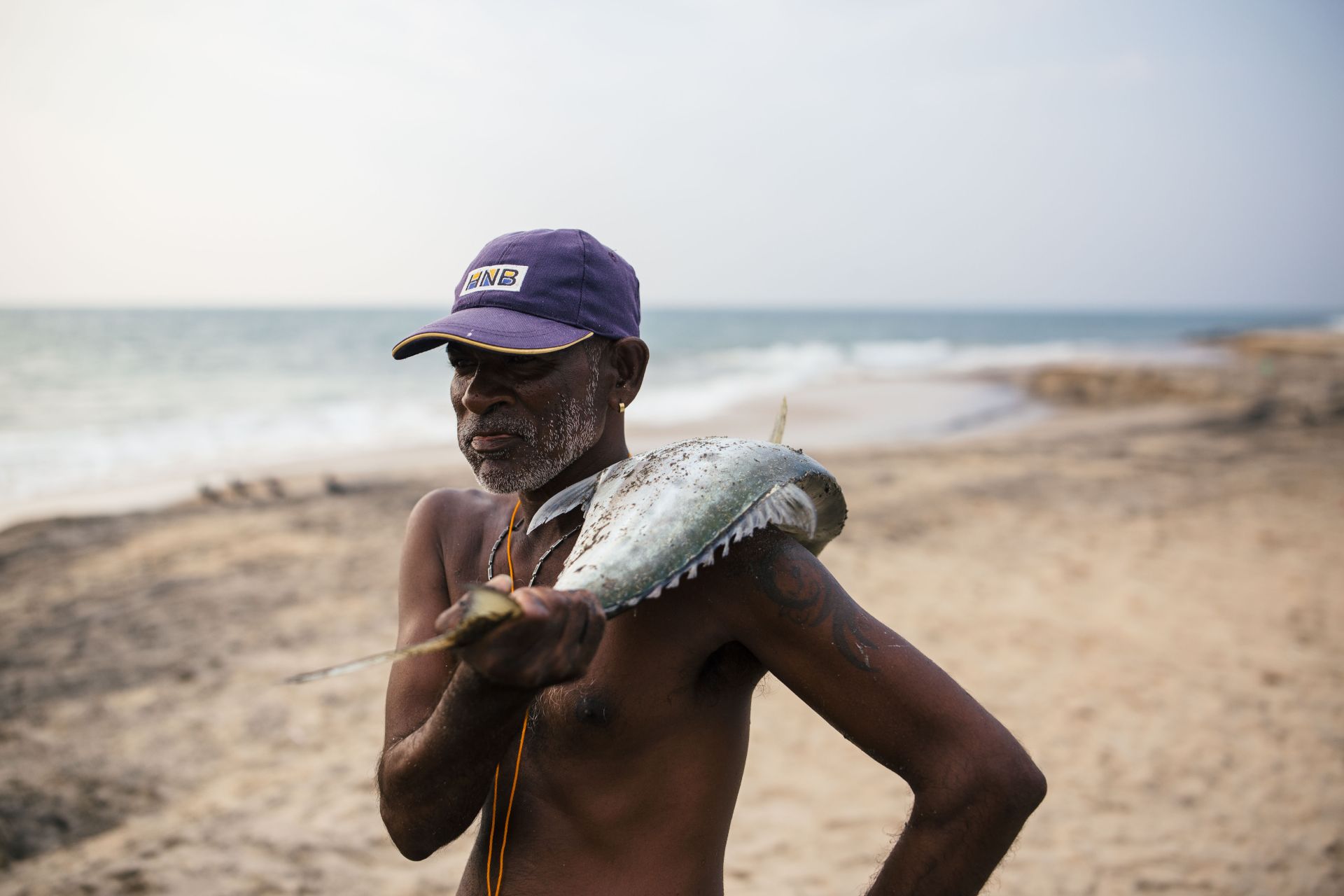“Spotlight” is a newsletter about underreported cultural trends and news from around the world, emailed to subscribers every Tuesday and Thursday. Sign up here.
Before the first rays of dawn illuminate the shores of Negombo lagoon in western Sri Lanka, Marcus is already heading back to shore on his paddle boat after a night out on the open water. The 52-year-old fisher learned the trade at a young age from his father, who in turn had fished with his father. It was just an OK day, he says. As of late, the waves tend to feel rough and good fish are harder to catch. The stress from spiking fuel prices has made it increasingly tough for Marcus to support his family of five as well.
An estimated 3 million Sri Lankans are involved in fishing and aquaculture, supplying nearly half the country’s animal protein. Fish are also a key export, with the commercial fishing industry garnering an estimated income of $287 million in 2021. Large fishing expeditions, often multiday or monthslong, supply most exported catches. Yet as many as 30% of the 200,000 or so small-scale coastal fishers still use traditional methods.
Beach seining — which involves a collective of 20 to 40 fishers using a single net to surround a school of fish — is communal by nature and described by researchers as the nation’s “single most important form of fishing.” The particulars of each beach seine, from the fish species targeted to the size of net used, vary greatly by region along the tropical island’s 800-mile coastline. Generations’ worth of close-knit interactions and indigenous knowledge have transformed Sri Lanka’s fishing industry into what it is today. Some communities have incorporated various degrees of mechanization into their work, such as motor boats or tractors with winches to help haul up heavy nets, but the cooperative core of the work endures.
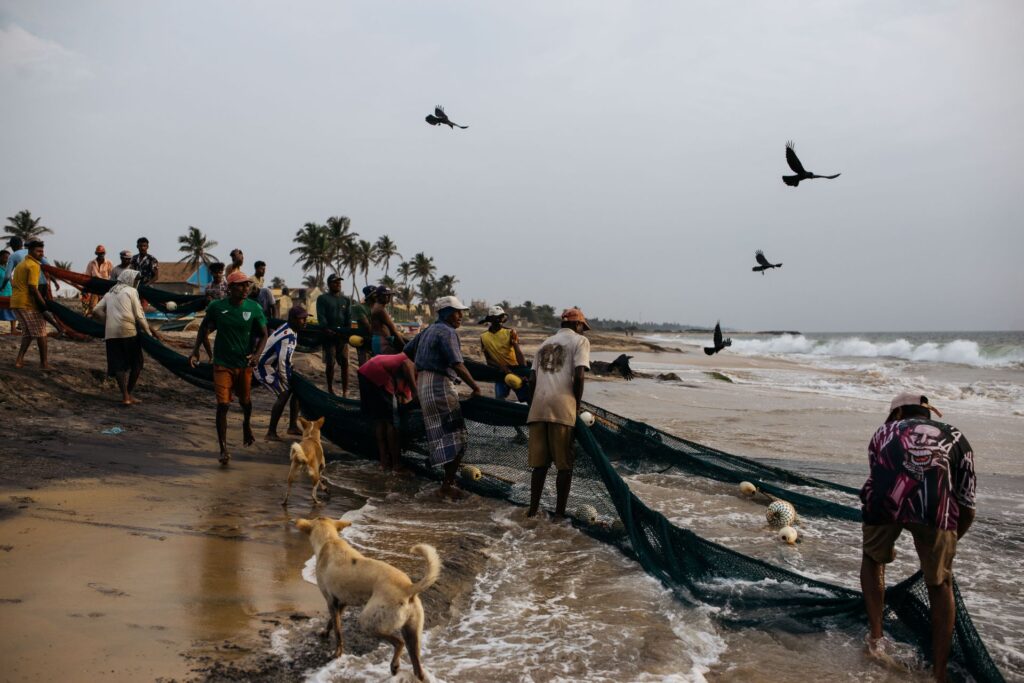
Beach seining was developed in tandem with a highly intricate sharing system. In some areas, such as along Negombo lagoon, this style of fishing has evolved into a monthly payment system, since many individual fishers can’t afford the gear required for a beach seine (a net can cost upward of $7,500). Yet through cleaning and selling fish or mending nets, those who indirectly participate, including women and youths, still have the chance to receive some income.
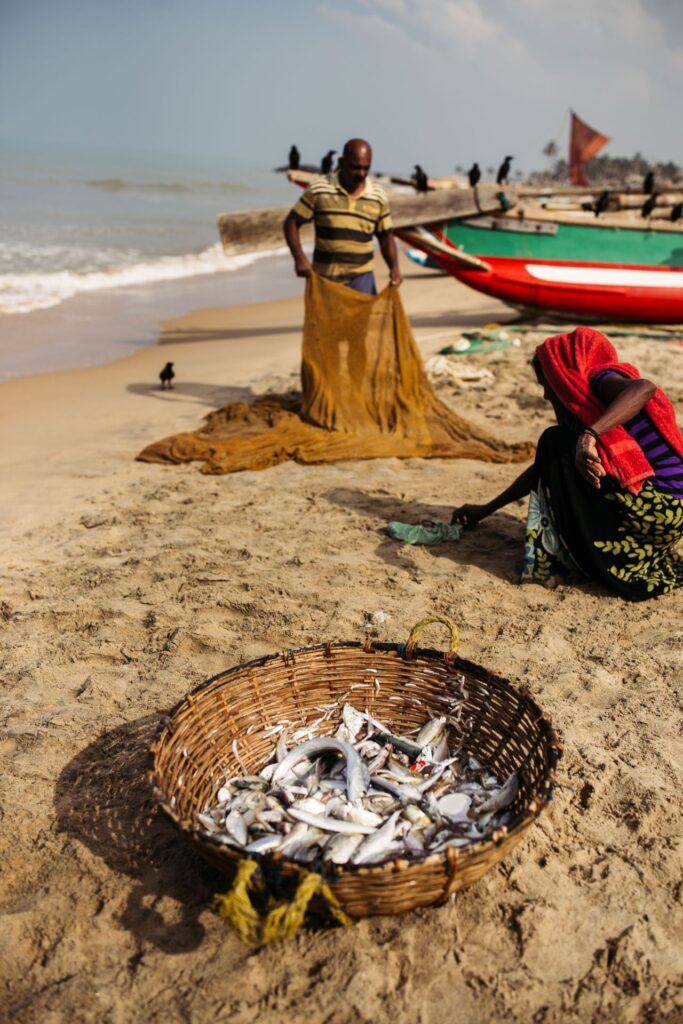
This unique cultural value runs deep within these coastal communities’ identity. And this is in a country where identity does not come easily: The nation is still processing the after-effects of a 26-year-long civil war that ended in 2009, with origins in postcolonial policies that pitted the Sinhalese-dominant government against Tamil minorities.
Fishing, particularly by traditional methods, is a skill based on an intimate knowledge of the seas, the seasonal fish migrations, physical endurance and a strong sense of cooperation. “Those who are not fishermen may see the work as dangerous, dirty and difficult,” said K.P.G.L. Sandaruwan, a socioeconomic and marketing researcher at the National Aquatic Resources Research and Development Agency (NARA) in Colombo, in an interview with New Lines. “Of course, it’s not an easy job. But the fishermen feel a kind of freedom to do what they do, be out on the water, as masters of their own jobs.”
Through his research, Sandaruwan has found that fishing communities tend to have different parameters for material well-being from those with more conventional jobs.
“It’s more about how you feel about yourself, confidence in your occupation and what kind of people you’re associated with than how big your house is,” he says.
Fishing professionally requires perseverance to tough out rough conditions, high physical risks, unpredictable catches and increasingly poor pay. The nation is in the midst of its worst economic crisis to date. A collapse in foreign currency reserves in 2022, culminating with the president fleeing the country on a military jet, led to dire shortages of food, medicine and fuel. A foreboding air seems to cloud the atmosphere of the beautiful island. Many citizens have been forced to reconsider their future in the country, as their work brings in less money by the day. More than 500 doctors, for instance, left Sri Lanka last year, with many more likely to follow.
Most small-scale Sri Lankan fishers have practically no cushion from recent spikes in inflation. Marcus says that, just last year, the 20 liters of fuel required to fill his boat cost 2,600 Sri Lankan rupees ($7). It has since tripled to 8,000 rupees ($22). He makes less than half that amount of money on a good day, he tells me. And what that paltry sum can buy for his wife, Maria, their two kids and a grandchild has been shrinking.
Marcus’s 24-year-old son also fishes, mostly by casting lines. Neither of them wants to change his livelihood and both lack the means to do so. But the uncertainty of the future has been taking a serious mental and emotional toll.
“I don’t mind that my house is small,” says Marcus, as Maria serves ginger tea in their home, where ceramic figurines of the holy family are displayed before a bare brick wall. “But now I’m worried about school fees, buying enough oil and rice.”
Aruna Maheepala, a socioeconomic and aquatic resources scientist at NARA, explains that Sri Lanka has two good fishing seasons per year — one from October to April on the west coast and the other from April to October on the east. During the peak seasons, fishers work every day of the week, depending on the conditions. They live in huts along the shoreline for convenient access to the water.
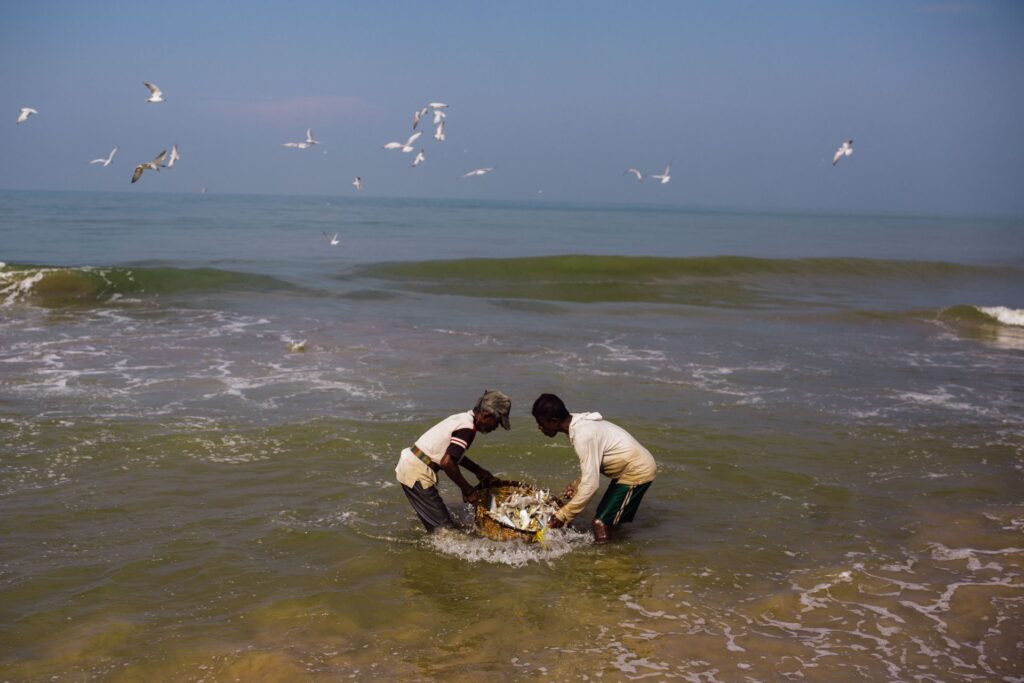
“There’s a bit of a migration in between seasons,” Maheepala notes. “Many migrate from coast to coast, following the schools of fish. They’ll go out on the water whenever the seas aren’t too rough.” But even this is changing, as these rural communities experience complex climate changes firsthand, with frequent extreme weather events resulting in floods and droughts.
According to Maheepala, lagoons (stretches of salt water separated from the sea by a prominent sandbar) are still the best places to witness traditional beach seining in action. Political unrest affected sea fishing zones in the eastern and northern areas. “After 1980, the [beginning of the] war, the supply chain and fisheries market collapsed,” Maheepala says. This happened after the advent of mechanization had taken some of the manual burdens off the fishers, and after rotational systems were established so they could continue sharing the fruits of their labor and expensive equipment. “But with increasing operation costs and no support from the government, things have become very difficult,” he explains.
The perilous combination of climate change, pollution and overfishing means that the catches themselves have been dwindling as well. There are fewer commercially viable species such as snappers, tuna and prawns in the more shallow waters adjacent to the coast — places that have sustained thriving communities for centuries and that fishers can access in their modest boats.
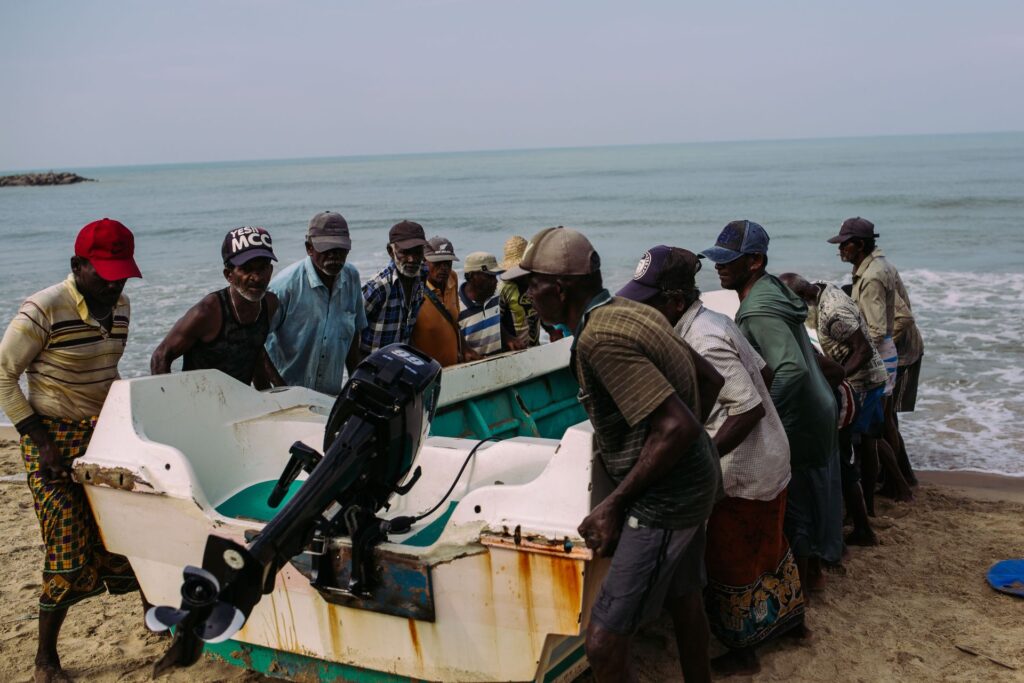
As environmental conditions worsen, the fisher’s generational knowledge is increasingly put to the test. Many have resorted to using finer nets, which gather smaller fish, to compensate for weak catches, but that means there’s a lot more bycatch and more immature fish are hauled up in the process. It’s a toxic cycle that further inhibits future fish populations’ ability to regenerate.
Sandaruwan also says that the high seas are getting rougher and the seasons themselves are changing. “Previously, fishermen knew what the starting and stopping date of monsoon rain and winds were. That’s how they planned their fishing activities. But now all climate patterns have changed, so they’re unable to predict fishing activities.”
The researcher continues: “For example, if fishermen could predict the weather pattern, they can decide what gear to use, which craft is suitable for fishing, and where the suitable grounds are. But now they can’t. Some fishermen go out to fish, but sudden rain or storms occur, damaging their lives and crafts.”
Research has shown that coastal communities have highly adaptive strategies that help them overcome challenges from climate, social economics and political turmoil. Yet the focus on indigenous knowledge remains limited and is rarely incorporated into governmental and NGO initiatives.
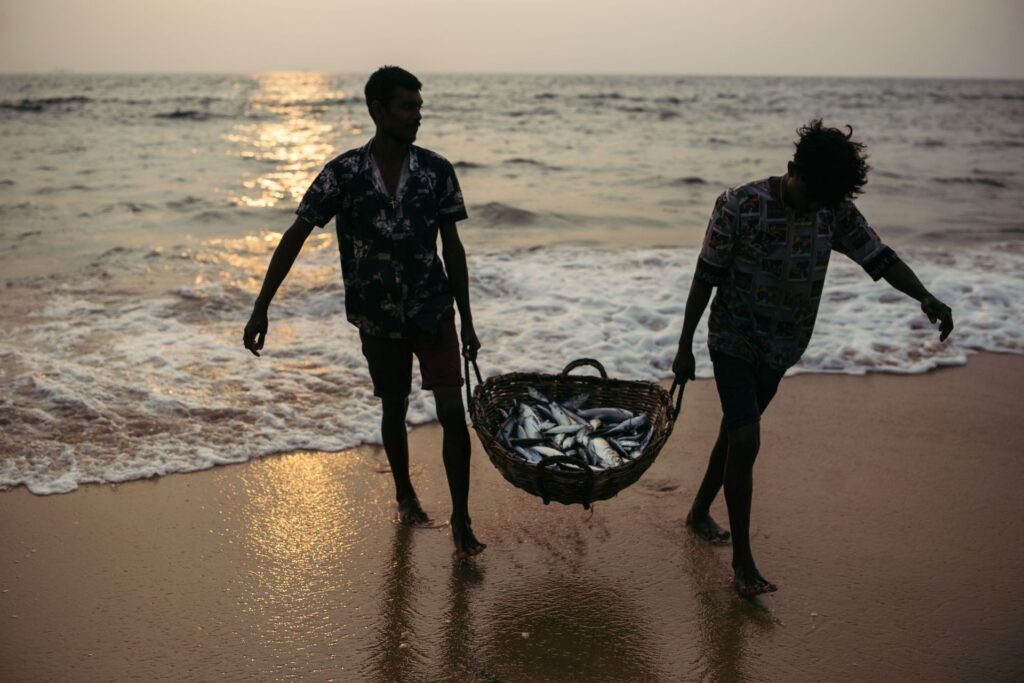
Maheepala describes these subsistence fishers as facing a Catch-22: They need to venture further out to catch enough fish to cover their costs, yet fuel prices are rising prohibitively. “It’s common for fishermen to take out loans,” he says. “Many don’t have much education and don’t have the practice of saving money or making good financial decisions.”
But for fishers like Marcus, fishing runs in his blood — it’s the foundation of his identity, where he came from and his family history. Switching to a different line of work would be unimaginable.
Sign up to our mailing list to receive our stories in your inbox.



